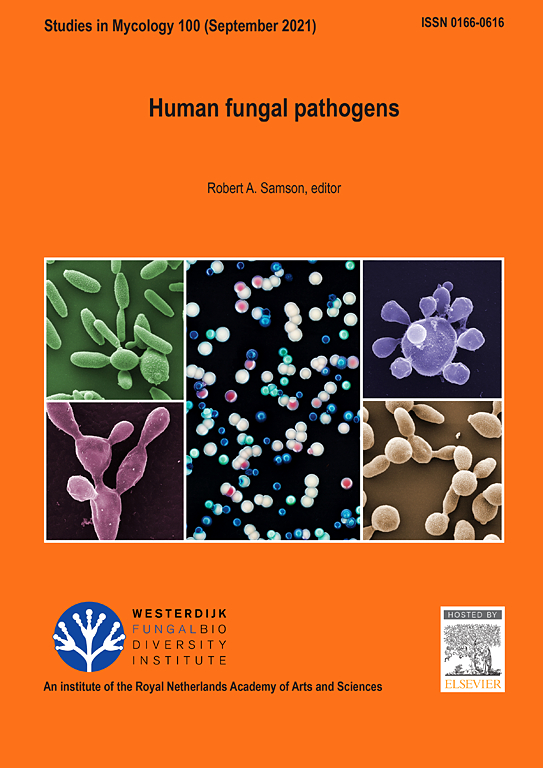The subfamily Xerocomoideae (Boletaceae, Boletales) in China
IF 14.1
1区 生物学
Q1 MYCOLOGY
引用次数: 0
Abstract
Xerocomoideae is an ecologically and economically important Boletaceae subfamily (Boletales) comprising 10 genera. Although many studies have focused on Xerocomoideae in China, the diversity, taxonomy and molecular phylogeny still remained incompletely understood. In the present study, taxonomic and phylogenetic studies on Chinese species of Xerocomoideae were carried out by morphological examinations and molecular phylogenetic analyses. Eight genera in Xerocomoideae, viz. Aureoboletus, Boletellus, Heimioporus, Hemileccinum, Hourangia, Phylloporus, Pulchroboletus, and Xerocomus were confirmed to be distributed in China; 97 species of the subfamily were accepted as being distributed in China; one ambiguous taxon was tentatively named Bol. aff. putuoensis; two synonyms, viz. A. marroninus and P. dimorphus were defined. Among the Chinese accepted species, 13 were newly described, viz. A. albipes, A. conicus, A. ornatipes, Bol. erythrolepis, Bol. rubidus, Bol. sinochrysenteroides, Bol. subglobosus, Bol. zenghuoxingii, H. squamipes, P. hainanensis, Pul. erubescens, X. albotomentosus, and X. fuscatus, 36 known species were redescribed, and the other 48 species were reviewed. Keys to accepted species of Aureoboletus, Boletellus, Heimioporus, Hemileccinum, Hourangia, Phylloporus, and Xerocomus in China were also provided.标题中国辣椒科辣椒亚科
椒科是一种生态和经济上重要的辣椒科亚科,由10个属组成。虽然对中国的干蛾亚科进行了大量的研究,但其多样性、分类和分子系统发育仍不完全清楚。本文通过形态学研究和分子系统发育分析,对中国的干蛾科植物进行了分类和系统发育研究。证实在中国有分布于干虫科的8个属,即:Aureoboletus、Boletellus、Heimioporus、Hemileccinum、Hourangia、Phylloporus、Pulchroboletus和Xerocomus;该亚科97种已被确认分布于中国;一个模棱两可的分类单元暂定名为Bol。aff. putuoensis;定义了两个同义词,即A. marroninus和P. dimorphus。在中国收录种中,新描述种13种,分别为:A. albipes、A. conicus、A. ornatipes、Bol。erythrolepis,波尔。rubidus,波尔。sinochrysenteroides,波尔。subglobosus,波尔。增火星,尖嘴贝,海南贝,Pul。对已知种36种进行了重新描述,并对其余48种进行了综述。并给出了中国公认的Aureoboletus、Boletellus、Heimioporus、Hemileccinum、Hourangia、Phylloporus和Xerocomus的分类键。
本文章由计算机程序翻译,如有差异,请以英文原文为准。
求助全文
约1分钟内获得全文
求助全文
来源期刊

Studies in Mycology
生物-真菌学
CiteScore
35.60
自引率
3.00%
发文量
7
期刊介绍:
The international journal Studies in Mycology focuses on advancing the understanding of filamentous fungi, yeasts, and various aspects of mycology. It publishes comprehensive systematic monographs as well as topical issues covering a wide range of subjects including biotechnology, ecology, molecular biology, pathology, and systematics. This Open-Access journal offers unrestricted access to its content.
Each issue of Studies in Mycology consists of around 5 to 6 papers, either in the form of monographs or special focused topics. Unlike traditional length restrictions, the journal encourages submissions of manuscripts with a minimum of 50 A4 pages in print. This ensures a thorough exploration and presentation of the research findings, maximizing the depth of the published work.
 求助内容:
求助内容: 应助结果提醒方式:
应助结果提醒方式:


